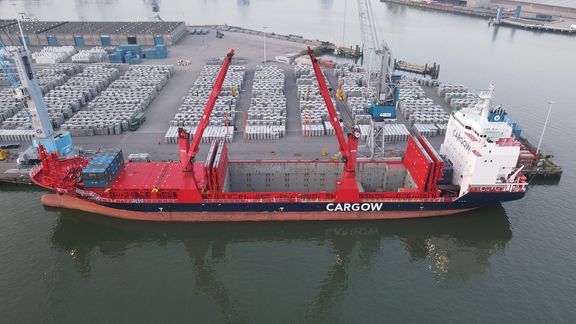Pilot for mobile shore-based power on hydrogen with Cargow at Steinweg
On the site of C. Steinweg - Handelsveem B.V. (Steinweg) Beatrix terminal in Eemhaven area near Rotterdam, a pilot project with a mobile facility for shore-based power on hydrogen for Cargow’s MPP (Multi purpose) vessels arriving twice a week is set to begin in late 2022.
The tendering process starts in February. The pilot is meant to intensify the use of shore-based power in the port and is part of a partnership between the Municipality of Rotterdam and the Port of Rotterdam Authority.

The collaboration began in December 2019, when a pilot was launched at Parkkade for supplying small sea-going vessels with electricity from the quay, or ‘shore-based power’ as it is called. Thanks to this method, the crew will no longer need to run the on-board diesel generators, resulting in reduced air pollution and noise.
Mobile shore-based power
During the pilot, several marketable concepts were put through real-world tests over a five-month period. Power consumption data was collected, and emissions and sound levels were measured. The pilot showed it is technically feasible to supply sea-going vessels with shore-based power using mobile concepts. The findings are being used to develop a permanent connection at Lloydkade as well as one at Parkkade later on. These findings are also a reason for the trialling of mobile shore power at the Steinweg location Beatrixhaven to start soon.
Cargow / Steinweg pilot
In most original terminal designs, the integration of any existing or future shore-based power has not been taken into account. Cranes, crane tracks and bollards nearby often impede the installation of equipment and cabinets for shore-based power and make connecting the cables between vessels and terminals a complex matter. To identify and remove such obstacles, the shore-based power project team of the municipality and PoR wants to set up a pilot at Steinweg as a follow-up to the Parkkade pilot. An autonomous, mobile installation with non-fossil fuel (hydrogen) will be tested within the framework of the energy transition.
Mobile solutions are required at sea port terminals where investments in shore-based power are less obvious. Tests are also being performed on a cable management system that can be deployed flexibly. The system should optimise the power supply between the quay and the vessel at quays where space is at a premium (at container terminals, for instance). What is more, measures are being conducted to gain better insight into consumption by vessels, to make optimisation of technical designs possible and restrict investment costs in order to make shore-based power possible on the quayside.
Steinweg will free the space required at the terminal for the pilot to proceed smoothly. It will also apply for a permit and ensure a safe working area by fencing it off. Cargow will convert two of its vessels to run on shore-based power in operational conditions. Steinweg and Cargow will be partially compensated for the project by the municipality and the Port Authority.
Shore-based power in Rotterdam
For over a decade, inland shipping has been using shore-based power in Rotterdam on a large scale. Shore-based power for sea-going shipping is complex, as electricity consumption is high and these vessels call at many different ports. Besides, many sea-going vessels do not have the proper connections for using shore-based power. As part of the shore-based power programme, we are collaborating with other ports to bring about connection standards for smaller sea-going vessels.

Furthermore, the container ports of Rotterdam, Antwerp, Bremen, Hamburg and Haropa (including Le Havre) are coordinating their plans for shore-based power, which will lead to standardisation, lower costs and acceleration of the use of shore-based power. In the Port of Rotterdam, the Stena Line terminal in Hoek van Holland has shore-based power. This year Heerema will also put into operation a shore-based power installation for its offshore vessels at Landtong Rozenburg.
Potential of shore-based power for maritime shipping
Calculations by DNV GL and the Port Authority indicate that the total energy demand of sea-going vessels in the port amounts to around 750-850GWh. This is equivalent to the energy consumption of some 200,000 households. This means there is much to be gained in terms of air quality, liveability and the climate. Using a joint strategy, the Port of Rotterdam is preparing itself for the transition to cleaner shipping.